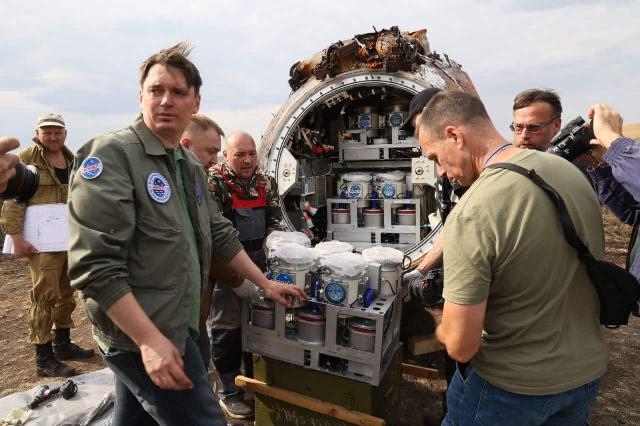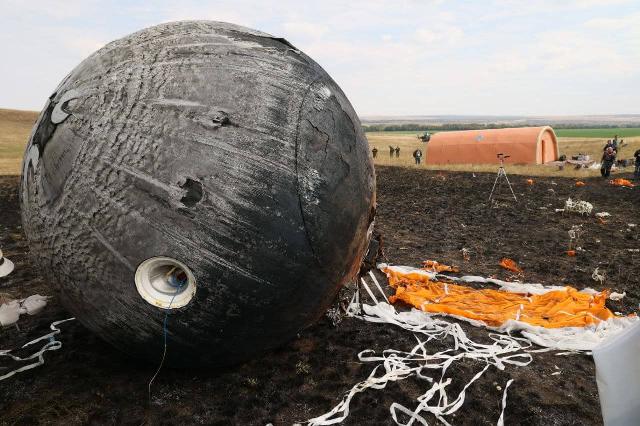The landing, including the burning of a piece of steppe, went smoothly, but some of the rodents on board died. However, it was not the increased cosmic radiation of the polar orbit that killed them, the effect of which on mammals was planned to be revealed in the mission, but more banal reasons.
Earlier, we wrote about the launch of Bion-M No. 2 into a polar orbit with an inclination of 97 degrees on August 20, 2025. After 30 days, the spacecraft returned to Earth in Kazakhstan. Since these biosatellites are technically a redesigned version of the Vostok spacecraft, on which Gagarin went into space 64 years ago, the return was accompanied by a small fire, which was natural for this area.
The fact is that the first Soviet spacecraft was developed in the late 1950s, after tests on pilots, where they came to the conclusion that a person easily tolerates an overload of 10 g. Therefore, the Vostok descends along a ballistic trajectory ("falls like a stone"), without significant maneuvering, as on the Soyuz, created in the 1960s and used by our country to this day. It is very difficult to ensure a low-speed landing on parachutes alone. Therefore, so that the first cosmonaut would not be inside a spherical capsule colliding with the Earth at a speed of 36 kilometers per hour, he jumped out of the ship with an individual parachute, due to which he landed like an ordinary paratrooper, with speeds about twice lower than the Vostokov ones.
But the 75 mice and fifteen hundred fruit flies that went into space aboard Bion-M No. 2 would be problematic to equip with a parachute and even more difficult to assemble them after an individual landing. To make the astronauts suffer less on impact, the Bions have a pair of small solid-fuel engines at the top, in the area where the container with the braking parachute is attached, which give a brief braking impulse before landing. Logically, they ignite dry grass when triggered. Normally, a fire is not dangerous to the capsule itself: in order for the crew to survive passage through the atmosphere along a ballistic trajectory, the device is sufficiently thermally stable even for short-term heating to a couple of thousand degrees.

The modest size of the returned capsule and the animal nests placed in it are clearly visible.
Image source: IMBP RAS
Immediately after landing, scientists from the Institute of Biomedical Problems of the Russian Academy of Sciences conducted a primary analysis of the condition of the returned animals in a medical tent. It turned out that although everything technically went well, some of them died. As Academician Orlov, director of the State Scientific Center of the Institute of Biomedical Problems of the Russian Academy of Sciences, noted, "out of 75 mice, we missed 10 ... The cause of death of these animals is different. Because these are male mice, aggressive animals with complex intra-group conflicts. The data, of course, is not missing, we will find out at what stages and for what reason they died."
The main object of Bion-M's experiments No. 2 were mice of the well-known C57BL line/6. In terms of aggressiveness, they do not stand out among their kind, their males are even less prone to conflict than those of people who grew up in natural conditions. For example, another mass line of CD-1 mice is noticeably more combative.
A short video from one mouse nest on a biosatellite / © IMBP RAS In order for C57BL/6 males to start killing each other, they need certain conditions — for example, large crowding. Judging by the videos from the Bion-M No. 2, this was quite observed there. Although, of course, it is not yet possible to say definitively whether the death of a dozen rodents was the result of it, or whether other factors were at work here. This is not the first time that insufficient attention to the organization of rodent "nests" in experiments has led to well-known problems.
For example, in 2013, Bion-M No. 1 lost all the Mongolian gerbils participating in the experiment, because the feeder for them stopped working correctly in zero gravity. One of the starved gerbils got out of the cage and chewed through the wires, which led to a disruption in oxygen supply. Of course, normally nests for rodents should be resistant to animals leaving them. At the same time, six black mice of the same lineage as in the 2025 experiment died, as well as cichlid fish. However, the equipment for their life support was already made by German experimenters, and not by the Russian side.
The new experiment, apparently, went much better: there were fewer losses among rodents, and the main program to study the effects of cosmic radiation on mice could well be completed. Some of them have been genetically modified to optimally study the effects of cosmic radiation on mammals, while others have received pharmacological effects to study the protective effects of certain drugs on living beings.
Earlier, the head of Roscosmos noted that the Bion-M experiment No. 2 could influence the choice of an orbit for the future Russian space station ROS.

